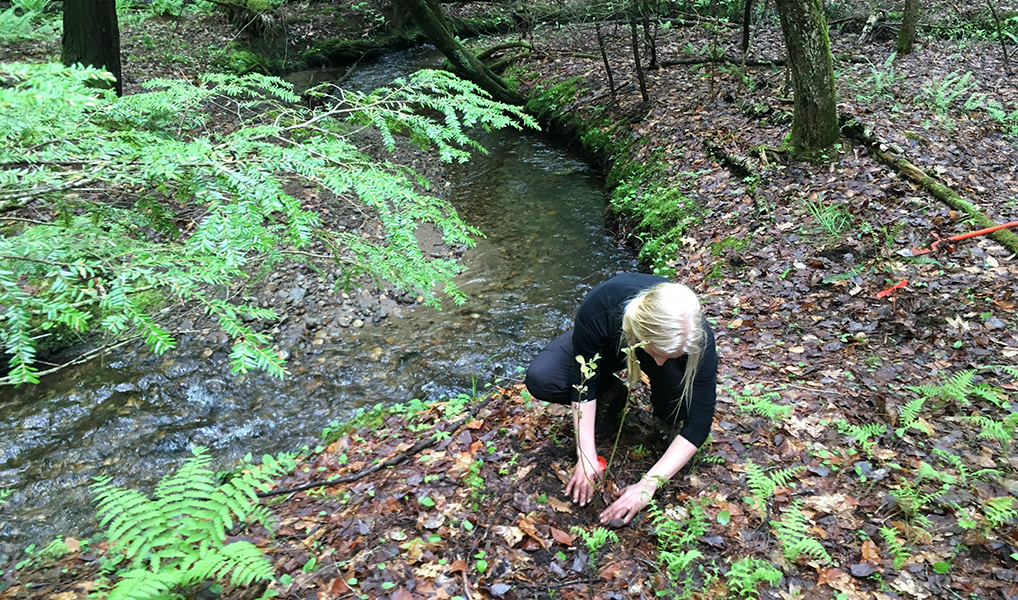STEWARDSHIP
Stewardship on Lake George is a blend of property management, active biological management, ecological monitoring and research.
The goal of land stewardship for the Lake George Land Conservancy is to protect the water quality of Lake George through land management practices and to sustain the existing diversity of species and natural processes that shape a landscape, or to restore them where they have been removed.
Most preserves are too small and fragmented to host all natural processes to which flora and fauna are adapted and under which the species evolved. Therefore, many preserves need active biological management to maintain their native species and natural communities.
Want to learn more? Watch our video spotlighting the importance of stewardship and education or follow our land steward Alex Novick on Instagram, @LGLC_Stewardship!

When the Lake George Land Conservancy establishes a preserve, ecological restoration is often needed to help restore areas of the property to a more natural state and to help re-establish the natural processes that should occur. Methods that have been employed to assist the restoration include the planting of native trees in former logging landings and gravel pits, hydroseeding the same areas, and controlling invasive plants.
With the help of volunteers and local school groups, native tree seedlings have been planted at several preserves to help give natural forest succession a boost in areas that have been scarred by past activities. Warren County Soil and Water Conservation District also assisted the LGLC to hydroseed disturbed areas with seeds of native plants. These areas were previously used as gravel pits, and were susceptible to erosion because the ground cover was removed.
The LGLC works to monitor and manage terrestrial invasive plants and invasive insects that are established and negatively impacting our forests and shorelines, or are not here yet but expected to infest the Lake George watershed in the near future. Click here for more information about invasive species and what the LGLC is doing to control them.
The purpose of erosion control around Lake George is to reduce the damage that water causes as it flows downhill. This can be caused by heavy or prolonged rain events, or even spring snow melt. Erosion control is always a concern when dealing with land issues, both on and off trails. Along trails, heavy storms can wash out sections of trails, or damage them severely. One method used to help divert water from the trails is the use of waterbars. Waterbars can take the form of many shapes and sizes, but the idea is always the same: attempt to re-direct flowing water off the trail. Generally, waterbars are trenches that are dug into the trails at about 30-degree angles. As water comes down the trail, and hopefully before it gains momentum, it flows into these trenches and is directed off to the side. Waterbars require annual maintenance in order to work properly. Any sediment that is deposited by runoff in these channels must be removed to provide a clear drainage path.
Erosion can also take place in areas of bare ground, such as abandoned gravel pits. In these areas, the LGLC has used hydroseeding and tree planting to help re-establish a vegetative layer that will hold the soil in place in order to avoid increased sedimentation caused by stormwater flowing down slopes.
The Lake George Land Conservancy manages over 39 miles of trails. These trails are open to the public year-round for hiking, snow-shoeing, and cross-country skiing. While most trails lead visitors to views of Lake George, some take people to other destinations, such as waterfalls and beaver ponds. All trails are marked with round, colored LGLC markers along the sides of the pathways, and visitors are encouraged to pick up a trail guide at the preserve kiosks to acquaint themselves with the routes and marker colors.
Along with the planning and design aspects of creating trails, a major focus is the continual maintenance needed to make sure the trails are marked accurately and free of debris, as well as to monitor any damage done to the trails or surrounding areas by illegal use or storm damage. Downed trees are removed and brush and encroaching tree limbs are cut back to provide safe and visible walkways to guests. In places where culverts are installed under the trails, the openings of these drainage pipes must be cleaned out to ensure proper water flow. Another means of water control is to create waterbars on the slopes of the trails. See Erosion Control, above, for additional detail on waterbars.
Sometimes more intensive work is required to ensure the long-term health and sustainability of a trail. In the case of our Schumann Preserve at Pilot Knob, which receives nearly 10,000 visitors each year, we hired a consulting firm in 2017 that specializes in trail construction to design and install an updated trail system that can withstand the heavy use, while minimizing erosion and other damage to the land.
Protecting the land that protects the lake since 1988. The Lake George Land Conservancy is an accredited not-for-profit land trust dedicated to working with willing landowners and other partners to protect the world-renowned water quality of Lake George and to permanently preserve the natural, scenic, historical and recreational resources of the Lake George Region.